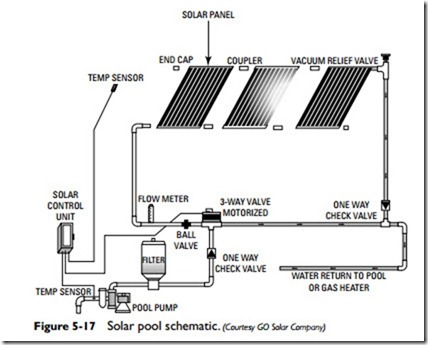Solar Pool Heaters
The principal components of a solar pool heating system are illustrated in Figure 5-17. In this system, the solar panels or collectors
function as the heater. There is no component similar to the heaters used in the more conventional pool heating systems. Note, how- ever, that an auxiliary heater may be included in the system as a backup to the solar collectors when there is not enough sunlight to warm the water.
In operation, water is automatically pumped through the solar collectors where it picks up the heat from the sun. A solar sensor is used to measure the heat on the panel. If the panels are cold, the solar sensor causes the water to bypass the panels and flow directly to the auxiliary heater (commonly a gas or electric heater) where it is heated and sent to the pool. If the solar sensor detects heat on the panels, it opens a valve to send the water directly to the solar panels where it is heated and then returned to the pool. At the same time, a bypass ball valve closes and isolates the auxiliary heater.
The temperature of the pool water is measured by a water sensor. Both the solar sensor and water sensor are connected to a controller that governs the operation of a three-way valve. A check valve in the piping leading from the three-way valve can be used to
isolate the pump, filter, and water sensor from other components in a solar heating system. The isolation valves installed in the solar panel supply and return lines are optional. The former is a ball valve, the latter a check valve.
The solar collectors are made from polypropylene or a similarly formulated material designed to withstand extreme exposure to weather conditions and pollution. The panel material is also unaffected by pool chemicals and will not corrode or rust. Each panel is constructed in a tube and curved web design to trap the heat as the sun moves across the sky.

